With独立主格结构大全课堂
- 格式:ppt
- 大小:226.00 KB
- 文档页数:14
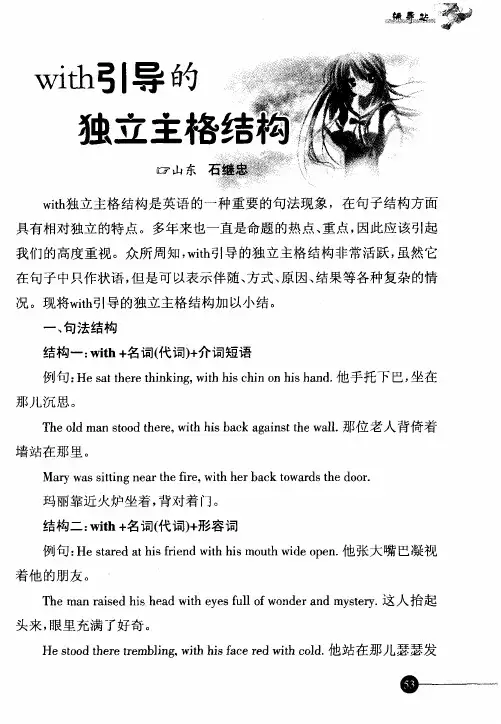


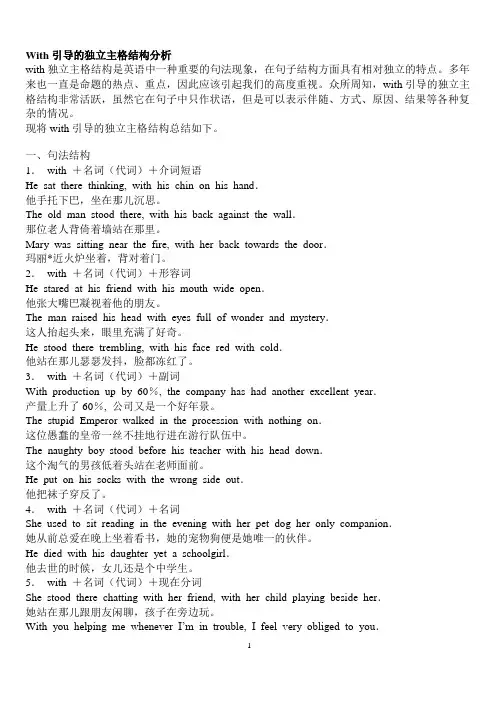
With引导的独立主格结构分析with独立主格结构是英语中一种重要的句法现象,在句子结构方面具有相对独立的特点。
多年来也一直是命题的热点、重点,因此应该引起我们的高度重视。
众所周知,with引导的独立主格结构非常活跃,虽然它在句子中只作状语,但是可以表示伴随、方式、原因、结果等各种复杂的情况。
现将with引导的独立主格结构总结如下。
一、句法结构1.with +名词(代词)+介词短语He sat there thinking, with his chin on his hand.他手托下巴,坐在那儿沉思。
The old man stood there, with his back against the wall.那位老人背倚着墙站在那里。
Mary was sitting near the fire, with her back towards the door.玛丽*近火炉坐着,背对着门。
2.with +名词(代词)+形容词He stared at his friend with his mouth wide open.他张大嘴巴凝视着他的朋友。
The man raised his head with eyes full of wonder and mystery.这人抬起头来,眼里充满了好奇。
He stood there trembling, with his face red with cold.他站在那儿瑟瑟发抖,脸都冻红了。
3.with +名词(代词)+副词With production up by 60%, the company has had another excellent year.产量上升了60%, 公司又是一个好年景。
The stupid Emperor walked in the procession with nothing on.这位愚蠢的皇帝一丝不挂地行进在游行队伍中。
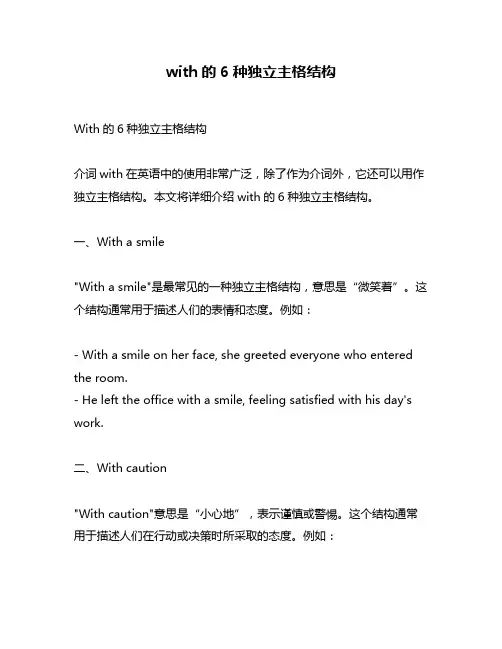
with的6种独立主格结构With的6种独立主格结构介词with在英语中的使用非常广泛,除了作为介词外,它还可以用作独立主格结构。
本文将详细介绍with的6种独立主格结构。
一、With a smile"With a smile"是最常见的一种独立主格结构,意思是“微笑着”。
这个结构通常用于描述人们的表情和态度。
例如:- With a smile on her face, she greeted everyone who entered the room.- He left the office with a smile, feeling satisfied with his day's work.二、With caution"With caution"意思是“小心地”,表示谨慎或警惕。
这个结构通常用于描述人们在行动或决策时所采取的态度。
例如:- With caution, he approached the wild animal.- She opened the package with caution, not knowing what was inside.三、With pleasure"With pleasure"意思是“乐意地”,表示愿意或高兴地做某事。
这个结构通常用于回答别人的请求或邀请。
例如:- "Can you help me move this table?" "With pleasure!"- "Would you like to join us for dinner?" "With pleasure!"四、With difficulty"With difficulty"意思是“费力地”,表示某事情很难做到,需要付出很大努力。
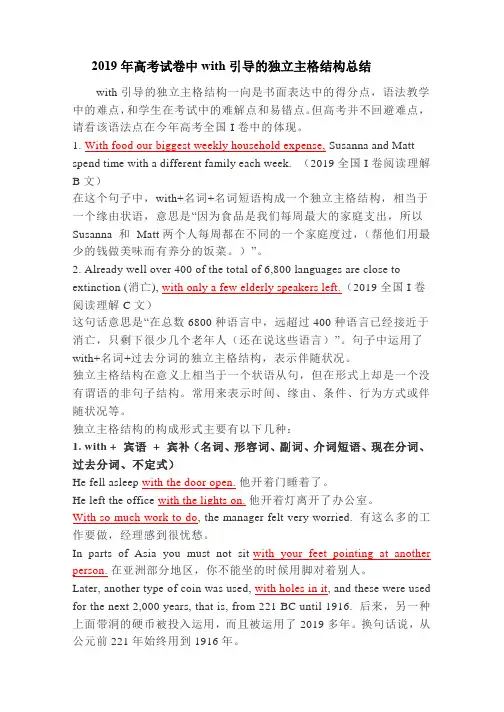
2019年高考试卷中with引导的独立主格结构总结with引导的独立主格结构一向是书面表达中的得分点,语法教学中的难点,和学生在考试中的难解点和易错点。
但高考并不回避难点,请看该语法点在今年高考全国I卷中的体现。
1. With food our biggest weekly household expense, Susanna and Matt spend time with a different family each week. (2019全国I卷阅读理解B文)在这个句子中,with+名词+名词短语构成一个独立主格结构,相当于一个缘由状语,意思是“因为食品是我们每周最大的家庭支出,所以Susanna 和Matt两个人每周都在不同的一个家庭度过,(帮他们用最少的钱做美味而有养分的饭菜。
)”。
2. Already well over 400 of the total of 6,800 languages are close to extinction (消亡), with only a few elderly speakers left.(2019全国I卷阅读理解C文)这句话意思是“在总数6800种语言中,远超过400种语言已经接近于消亡,只剩下很少几个老年人(还在说这些语言)”。
句子中运用了with+名词+过去分词的独立主格结构,表示伴随状况。
独立主格结构在意义上相当于一个状语从句,但在形式上却是一个没有谓语的非句子结构。
常用来表示时间、缘由、条件、行为方式或伴随状况等。
独立主格结构的构成形式主要有以下几种:1. with + 宾语+ 宾补(名词、形容词、副词、介词短语、现在分词、过去分词、不定式)He fell asleep with the door open.他开着门睡着了。
He left the office with the lights on.他开着灯离开了办公室。
With so much work to do, the manager felt very worried. 有这么多的工作要做,经理感到很忧愁。
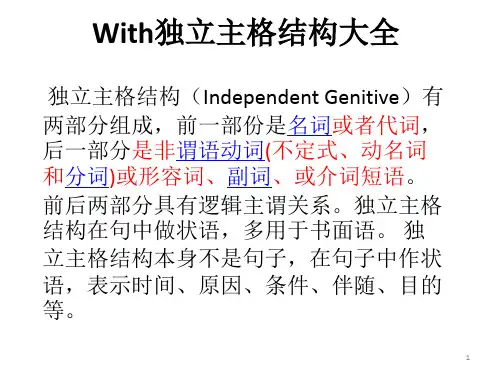
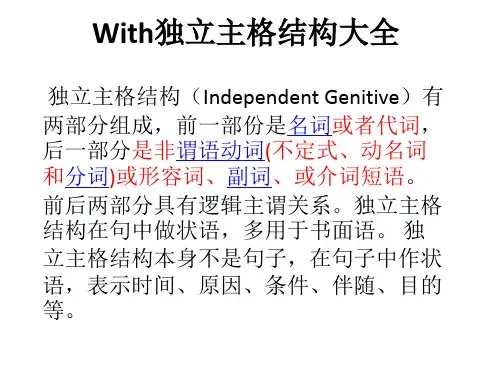

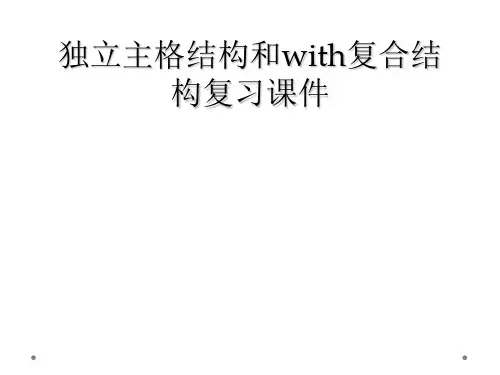
![独立主格结构和with复合结构复习[课件]](https://uimg.taocdn.com/af546faecc22bcd126ff0cda.webp)
w i t h引导的独立主格结构讲解与练习with引导的独立主格结构英语中,with引导的独立主格结构很富有表现力,在句子中作状语,表示伴随、方式、原因、结果等。
它不是句子而是短语,其结构为:with+名词/代词+介词短语/形容词/副词 / 名词/非谓语动词。
公式:with+宾语+宾补(with复合结构)。
现将with引导的独立主格结构作一小结。
1. with +名词(代词)+介词短语He sat there thinking, with his chin on his hand.他手托下巴,坐在那儿沉思。
The old man stood there, with his back against the wall.那位老人背倚着墙站在那里。
Mary was sitting near the fire, with her back towards the door.玛丽靠近火炉坐着,背对着门。
2. with +名词(代词)+形容词He stared at his friend with his mouth wide open.他张大嘴巴凝视着他的朋友。
The man raised his head with eyes full of wonder and mystery.这人抬起头来,眼里充满了好奇。
He stood there trembling, with his face red with cold.他站在那儿瑟瑟发抖,脸都冻红了。
3. with +名词(代词)+副词With production up by 60%, the company has had another excellent year.产量上升了60%, 公司又是一个好年景。
The stupid Emperor walked in the procession with nothing on.这位愚蠢的皇帝一丝不挂地行进在游行队伍中。
一、独立主格构造的含义和实质"独立主格构造〞〔absolute construction〕又叫"独立构造〞,是带有自己主语的非谓语动词分句和无动词分句。
由于在语法上有自己的逻辑主语,构造上与主句不发生关系,因此传统语法叫做"独立主格构造〞。
其实,所谓"独立主格构造〞并非真正独立,它还是一种附属分句,与主句严密联系在一起,共同表达一个完整的意思,通常在句中起状语分句的作用。
独立主格构造可放于句首、句尾,用逗号和主句隔开。
二、独立主格构造的根本形式和功能独立主格构造可以分为两局部:一局部是名词或代词,起逻辑主语的作用;另一局部是非谓语动词分句〔现在分词、过去分词、不定式〕或无动词分句〔名词、形容词、副词、介词短语〕,表示前面名词或代词的动作或状态。
根本形式是:名词普通格/代词主格+现在分词/过去分词/不定式/名词/形容词/副词/介词短语,with引导的复合构造。
1.名词/代词+ 现在分词〔主动、进展〕现在分词表示前面的名词或代词主动进展的动作或状态等。
例The monitor being ill, we’d better put the meeting off.班长病了,我们最好还是延期开会吧。
The question being settled, we went home.问题解决之后,我们就回家了。
We shall play the match tomorrow, weather permitting.明天假设天气好,我们就进展比赛。
So many students being absent, the meeting had to be put off.His homework having been done, Tom went to sleep.注:"独立构造〞中的being或 having been 有时可以省去,这样就成了无动词分句或过去分词分句。